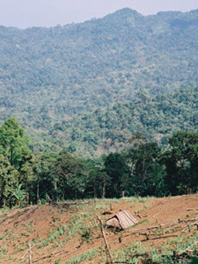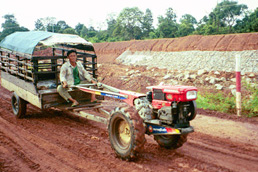4.3 INFLUENCES OF HUMAN ACTIVITIES ON WATER
BALANCE IN RIVERS
Impact of agriculture / Impact of reservoirs on the flood pulse / Impact of water transfers
Man's activities in the river basin influence the hydrological regime and water balance. Several activities in particular are important:
• Removal of forest cover;
• Dam building;
• Agriculture; and
• Water transfers.
Importance
of Forest Cover for Water Balance--
Forest cover is important in regulating water balance. All forest influences
rainfall on the basin through the microclimates it produces by transpiration.
Such microclimates may increase the amount of rain falling within the
basin, and in some areas where forests have been removed, the local climate
has become significantly dryer. At the same time, transpiration can remove
quantities of water from the soil and reduce the amount reaching the river.
Forest cover also changes the way in which the rainfall reaches the earth,
which differs from other types of ground cover such as grassland, or cultivated
or naked soil. Rainfall falling over forested areas is dispersed by the
canopy of leaves and  does
not have the energy of drops falling directly on the soil. It is also
more dispersed in time as the water held in the canopy is released over
a longer period, although the timing of the flood and the flood peak are
not altered. Forest soils are generally more absorbent than soils exposed
directly to the sun, which may become hard and relatively impermeable;
so, less water reaches streams from forested areas than from grassland
or denuded areas leading to reductions in the base flow. Forests therefore
retain water from rainfall in the soil and release it over a greater period
of time than do landscapes with no forest cover. This directly influences
water regimes by reducing the flashy nature of the hydrograph that would
otherwise respond directly to rainfall.
does
not have the energy of drops falling directly on the soil. It is also
more dispersed in time as the water held in the canopy is released over
a longer period, although the timing of the flood and the flood peak are
not altered. Forest soils are generally more absorbent than soils exposed
directly to the sun, which may become hard and relatively impermeable;
so, less water reaches streams from forested areas than from grassland
or denuded areas leading to reductions in the base flow. Forests therefore
retain water from rainfall in the soil and release it over a greater period
of time than do landscapes with no forest cover. This directly influences
water regimes by reducing the flashy nature of the hydrograph that would
otherwise respond directly to rainfall.
The slower and more even run-off in forested areas, together with the
stabilizing structure of the root masses of the trees, protects the soil
from erosion. The more violent run-off in areas from which the forest
has been removed leads to much of the topsoil being washed into the streams
as silt. The crude agriculture practiced on deforested hill slopes further
accelerates the tendency of flashy hydrographs and to increased soil loss
leading to serious erosion, particularly on hill slope areas. The hydrograph
also responds faster to rainfall events in deforested areas.
Impact of Agriculture
on Flooding--
Agriculture represents a range of uses of land and water for growing crops.
In many areas natural rainfall is not enough and water is needed from
other sources. This problem is overcome in a number of ways. Agriculture
on the floodplain may be carried out as the water recedes and uses the
high water table of floodplains for the crops to be watered during the
dry season. More usually water is taken from the river or pumped from
the groundwater to irrigate crops. Enough water may be removed from rivers
to alter the amount of water available for other living aquatic organisms.
Agriculture on the floodplain for dry season crops often involves extensive
ditches that drain the water more rapidly from flooded areas. This can
alter the depth and duration of flooding of the floodplain.
 In
the Mekong there is a high dependence on rice culture. This crop is strongly
linked to natural floods and the floodplain has become extensively modified
by ditches and low dykes to contain the fields. These structural alterations
change the flow characteristic of the floodplain. In some areas sections
of the floodplain can be enclosed by polders, which are artificial levees
designed to exclude water from parts of the floodplain. These give a greater
control of the hydrological regime in favour of the rice or other water
associated crops such as melons. Tailoring flooding to the needs of a
crop changes the local flood characteristics and does not generally favour
other living component such as wild vegetation, invertebrates or fish.
In
the Mekong there is a high dependence on rice culture. This crop is strongly
linked to natural floods and the floodplain has become extensively modified
by ditches and low dykes to contain the fields. These structural alterations
change the flow characteristic of the floodplain. In some areas sections
of the floodplain can be enclosed by polders, which are artificial levees
designed to exclude water from parts of the floodplain. These give a greater
control of the hydrological regime in favour of the rice or other water
associated crops such as melons. Tailoring flooding to the needs of a
crop changes the local flood characteristics and does not generally favour
other living component such as wild vegetation, invertebrates or fish.